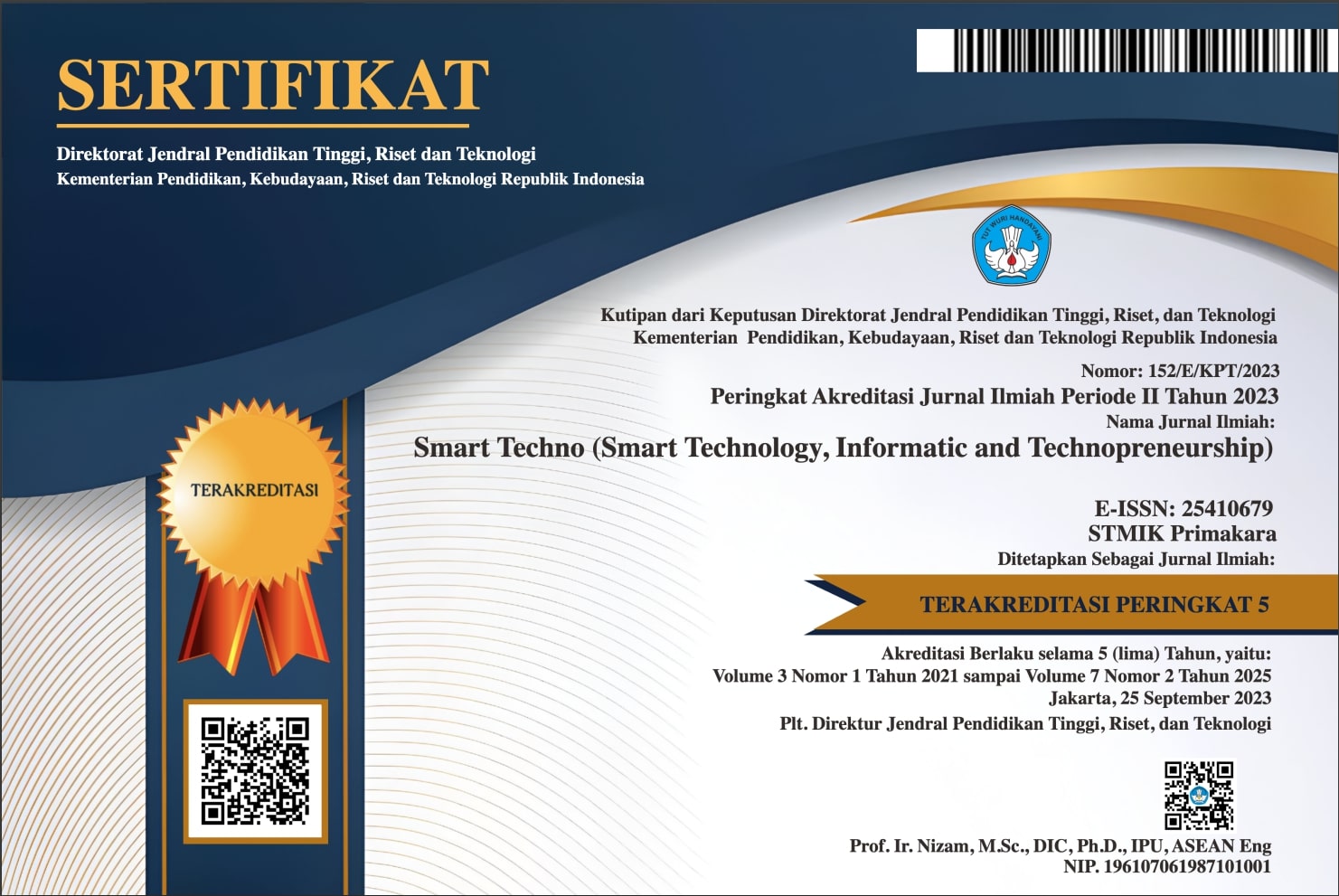Sistem Pendukung Keputusan Penerimaan Dan Penilaian Kinerja Pegawai
Abstract
Terdapat banyak masalah dalam proses penerimaan pegawai serta monitoring karyawan, seperti proses rekrutmen yang kompleks dan banyaknya pelamar yang mendaftar. Dari sinilah hadir gagasan untuk menggunakan sistem pendukung keputusan untuk membantu proses rekrutmen dan penilaian kinerja pegawai baru. Menggunakan metode K-NN dan Weithed Product penilaian kinerja dari karyawan menjadi salah satu aspek penting lainnya dalam mengembangkan sebuah perusahaan menjadi lebih efisien dan efektif. Ini dapat mempengaruhi kinerja perusahaan dan retensi karyawannya. Selain itu, Sistem Pendukung Keputusan Penerimaan dan Penilaian Kinerja Pegawai Baru ini dapat memberikan masukan atau opini kedua yang diperlukan untuk memilih calon karyawan terbaik dari pelamar yang ada. Jika penilaian kinerja ini tidak ada, maka kualitas kerja dari karyawan baru tersebut akan menjadi tidak terkontrol.
Downloads
References
[2] Z. Arifin and S. M. Wali Jafar Shudiq, "PENERAPAN METODE KNN (K-NEAREST NEIGHBOR) DALAM," vol. 4, no. 1, p. 2, 2019.
[3] BlogPress, "Mengenal Pengertian Website," BlogPress.id, 14 Juni 2020. [Online]. Available: https://www.blogpress.id/pengertian-website/. [Accessed 28 Oktober 2020].
[4] D. Kurniawan and A. Saputra, "Penerapan K-Nearest Neighbor dalam penerimaan peserta didik dengan sistem zonasi," vol. 2, no. 1, p. 3, 2019.
[5] E. S. S. Jodi Irjaya Kartika, "Penentuan Siswa Berprestasi Menggunakan Metode K-Nearest Neighbor (Studi Kasus : SMP Negeri 3 Mejayan)," vol. 1, no. 5, p. 3, 2017.
[6] CloudHost, "Mengenal Aplikasi Sublime : Cara Download Sublime Gratis dan Cara Kerjanya," CloudHost.id, 15 Maret 2020. [Online]. Available: https://idcloudhost.com/mengenal-aplikasisublime-cara-download-sublime-gratis-dan-carakerjanya/. [Accessed 28 Oktober 2020]. 69 70
[7] Y. R. Amalia, "Penerapan Data Mining untuk prediksi penjualan produk elektronik terlaris menggunakan metode k-nearest neighbor," 2018.
[8] N. L. G. P. Suwirmayanti, "Penerapan Metode KNearest Neighbor Untuk Sistem," vol. 16, no. 2, 2017.
[9] R. D. Sitepu and E. Buulolo, "IMPLEMENTASI ALGORITMA NEAREST NEIGHBOR PADA PENERIMAAN PEGAWAI BARU PADA MTS IKHWANUTS TSALITS TALUN KENAS," vol. 1, no. 1, 2017.
[10] S. S. Sundari and Y. F. Taufik, "Sistem Pendukung Keputusan Penerimaan Pegawai Baru Dengan Menggunakan Metode Simple Additive Weighting(SAW)," vol. 4, no. 2, 2014.
[11] E. Ismanto and N. Effendi, "Sistem Pendukung Keputusan Penerimaan Karyawan Dengan Metode Simple Additive Weighting (SAW," vol. 3, no. 1, 2017.
[12] A. J. T, D. Yanosma and K. Anggriani, "Implementasi Metode K-Nearest Neighbor (Knn) Dan Simple Additive Weighting (Saw) Dalam Pengambilan Keputusan Seleksi Penerimaan Anggota Paskibraka," vol. 3, no. 2, 2016.
[13] M. R. Alghifari and A. P. Wibowo, "Penerapan Metode K-Nearest Neighbor untuk Klasifikasi Kinerja Satpam Berbasis Web," vol. 5, no. 1, 2019. 71
[14] M. I. Ukkas, H. E. Yulsilviana and S. F. Muthia, Sistem Pendukung Keputusan Penilaian Kinerja Karyawan pada PT. Ranugas Utama menngunakan Metode K-Nearest Neighbor, vol. 1, no. 1, 2017.
[15] K. S. Dasa, I. P. Satwika and K. Q. Fredlina, "SISTEM PENDUKUNG KEPUTUSAN PEMBERIAN BEASISWA PPA DI STMIK PRIMAKARA," vol. 6, p. 3, 2020.
[16] I. G. J. E. Putra and A. A. G. A. W. Pemayun, "SISTEM PENDUKUNG KEPUTUSAN PENILAIAN KINERJA DOSEN DENGAN IT BALANCED," vol. 06, no. 1, p. 96, 2020.
[17] Binus University, "Mengenal Metode pembuatan sistem informasi Waterfall," Binus.ac.id, 13 November 2019. [Online]. Available: https://binus.ac.id/bandung/2019/11/mengenalmetode-pembuatan-sistem-informasi-waterfall/. [Accessed 9 November 2020].
[18] Guntoro, "Metode Waterfall : Pengertian, Tahapan, Contoh, Kelebihan dan Kekurangan," Badoy Studio, 13 Juli 2020. [Online]. Available: https://badoystudio.com/metode-waterfall/. [Accessed 9 November 2020].
[19] Hestanto, "Model Air Terjun (Waterfall Model)," [Online]. Available: https://www.hestanto.web.id/model-air-terjunwaterfall-model/. [Accessed 9 November 2020]
Copyright (c) 2023 I Putu Tejakusuma Dharma Yoga, Ketut Quenaa Fredlina, I Gede Juliana Eka Putra

This work is licensed under a Creative Commons Attribution 4.0 International License.
Authors who publish with the Smart Techno agree to the following terms:
- Authors retain copyright and grant the journal the right of first publication with the work simultaneously licensed under a Creative Commons Attribution License (CC BY-SA 4.0) that allows others to share the work with an acknowledgment of the work's authorship and initial publication in this journal.
- Authors are able to enter into separate, additional contractual arrangements for the non-exclusive distribution of the journal's published version of the work (e.g., post it to an institutional repository or publish it in a book), with an acknowledgment of its initial publication in this journal.
- Authors are permitted and encouraged to post their work online (e.g., in institutional repositories or on their website) prior to and during the submission process, as it can lead to productive exchanges, as well as earlier and greater citation of published work. (See The Effect of Open Access)







